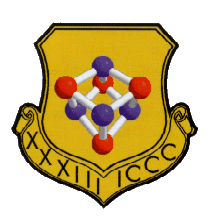 XXXIII INTERNATIONAL
CONFERENCE
XXXIII INTERNATIONAL
CONFERENCE XXXIII INTERNATIONAL
CONFERENCE
XXXIII INTERNATIONAL
CONFERENCEOn behalf of the Executive Organizing Committee, it is our pleasure to invite you to Florence for the 33rd International Conference on Coordination Chemistry from August 30 to September 4, 1998.
The Conference will be dedicated to Luigi Sacconi, as a tribute to a wonderful scientist and his willingness in bringing the 33rd ICCC to Florence.
The Conference program has been divided into six sessions which cover all of the areas of coordination chemistry, including those which are emerging in the scenario of the metal ion chemistry. We have scheduled nine plenary lectures which will be accompanied by a keynote lecture presenting "The View of a Nobel Laureate" . A special public pre-conference lecture will underline the links between our science and Society. In addition, four special sessions entitled "The way we were" will be a tribute to the history of Coordination Chemistry through the reminiscences of outstanding personalities. The great body of the conference program will consist of more than two-hundred invited lectures, among them a few lectures will be planned as tutorials on modern spectroscopic tools in coordination chemistry. Posters will be highlighted during two dedicated sessions and will be on exhibition at all times.
We trust that you will come to Florence and we will do our best to make your visit both scientifically rewarding and personally enjoyable.
Maurizio Peruzzini Ivano Bertini
Secretary Chairman
Vincenzo Caglioti - University "La Sapienza" , Rome Vittorio Carassiti - University of Ferrara Romano Cipollini - University "La Sapienza", Rome Paolo Corradini - University "Federico II", Naples Giacomo Costa - University of Trieste Lamberto Malatesta - University of Milan |
|
European Steering Committee |
Local Organizing Committee |
Coordination Chemistry is a branch of Science which regards the species and the reactions involving metal ions. Historically, it began to develop in the late fifties when the laws of chemical bonding involving the metal ions begun to be understood. Eventually, this science became the basis for the investigation and application of industrial catalysis, both in homogeneous and heterogeneous phases. In fact, most of the homogeneous catalysts are coordination compounds, typically the titanium-based compounds used in Ziegler-Natta polymerization reactions. In addition, most of the heterogeneous catalysts involve metal-substrate interactions.
The chemistry of metal ions, which is the essence of this conference as underlined by the subtitle, has exploded in the last decade due to its implications in new branches of science, including supramolecular chemistry which is a part of this meeting for what is in common with coordination chemistry. Typical examples of the chemistry of metal ions are magnetic materials, liquid crystals, electronic devices (including semi- and super-conductors), materials with non-linear optical properties, energy storage devices etc. Of course, all of these RTD strategies must take into account environmental compatibilities. Therefore great emphasis is given to the interaction of metal ions with living organisms, and particularly humans, e.g. how do lead and aluminium interact with proteins and tissues and what is the molecular basis of their toxicity?
Metal ions have quite recently been discovered to have a catalytic role in gene factors, DNA and RNA replications and in biological catalysis of many reactions in all metabolic processes.
Finally, metal ions have been discovered to play an important part in powerful drugs: from the famous cis-platinum and iron-bleomycin as anticancer drugs, to gold- and copper-containing drugs such as antiarthrytic. Metal ions are also often used as contrast agents, typically those used in magnetic resonance imaging.